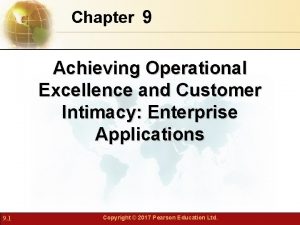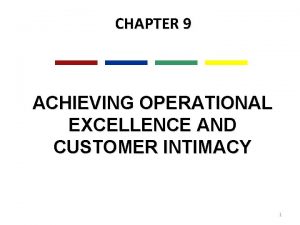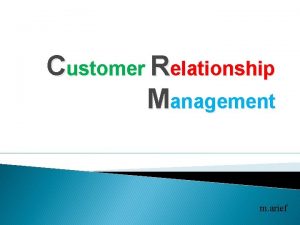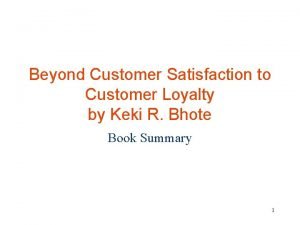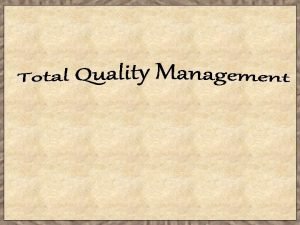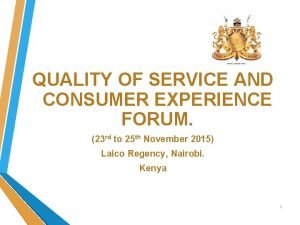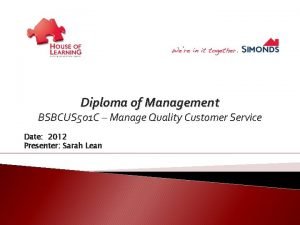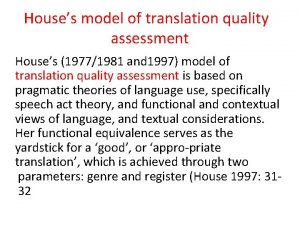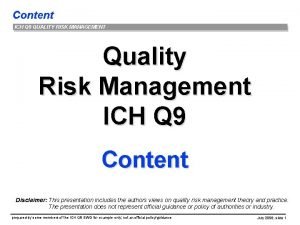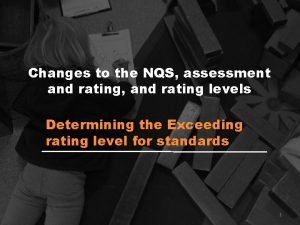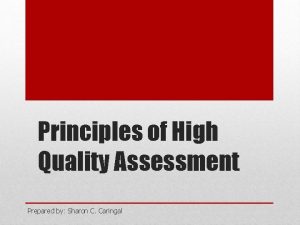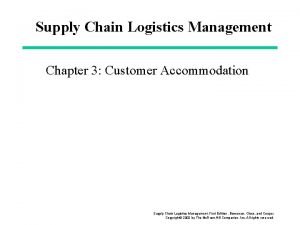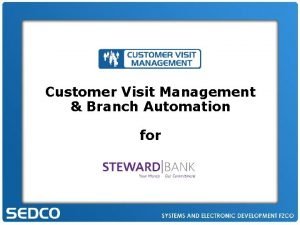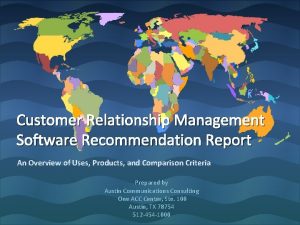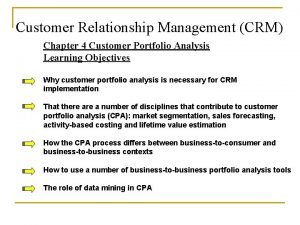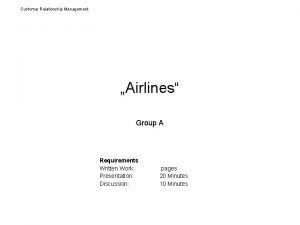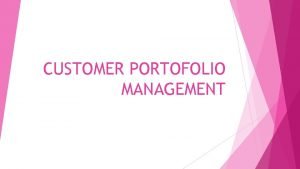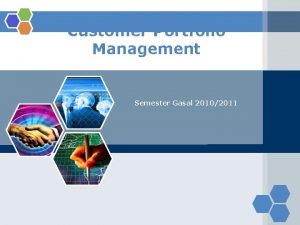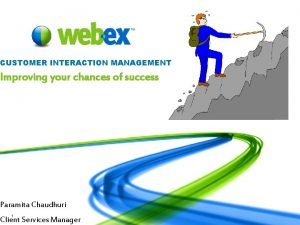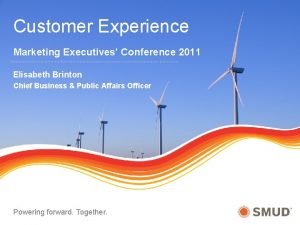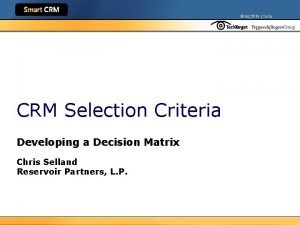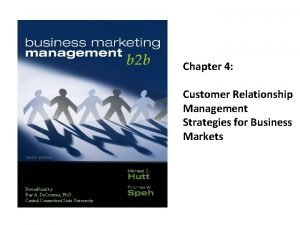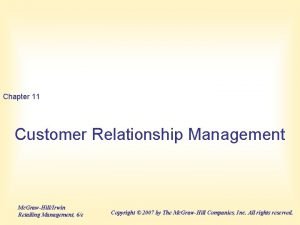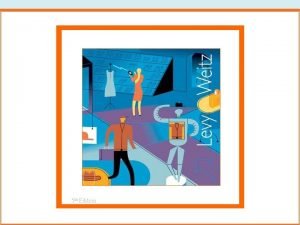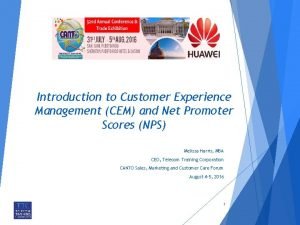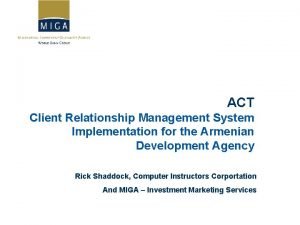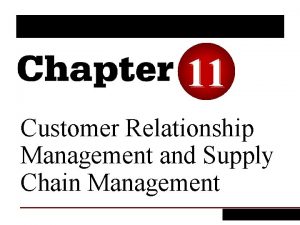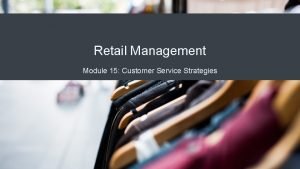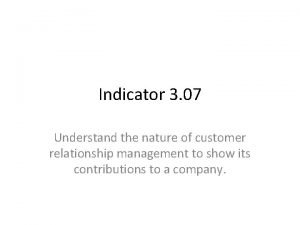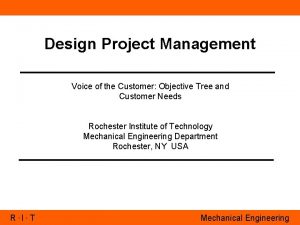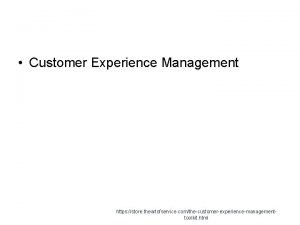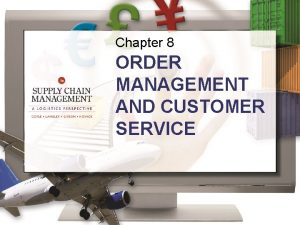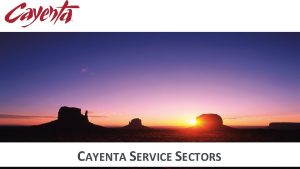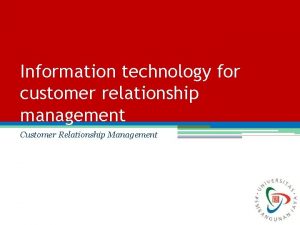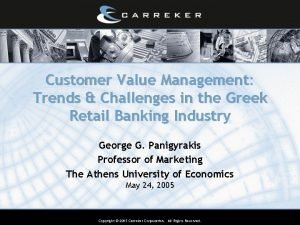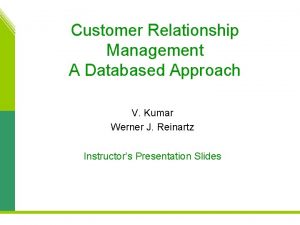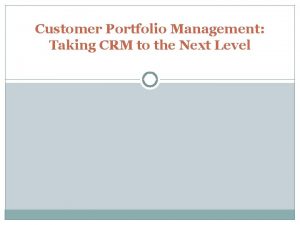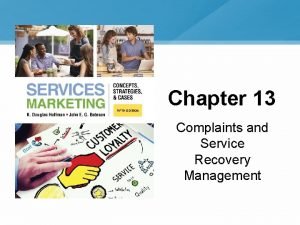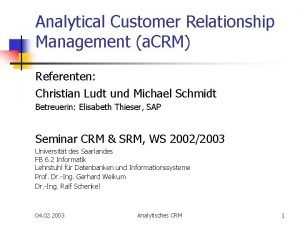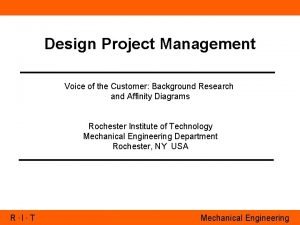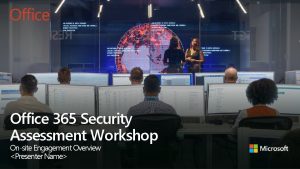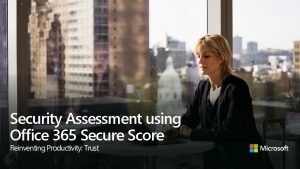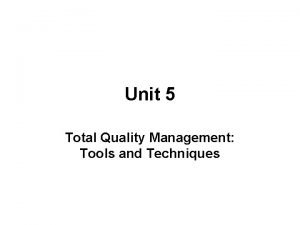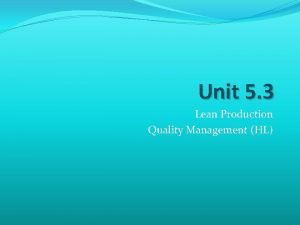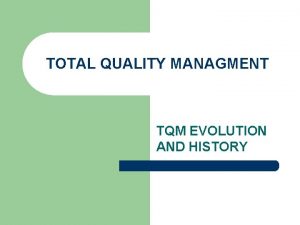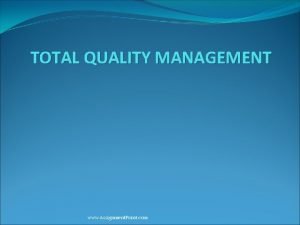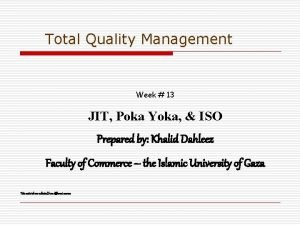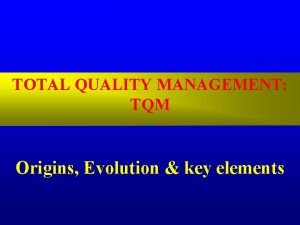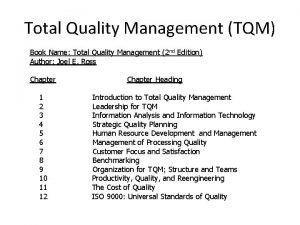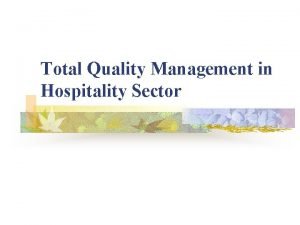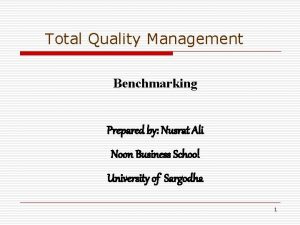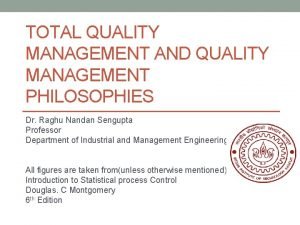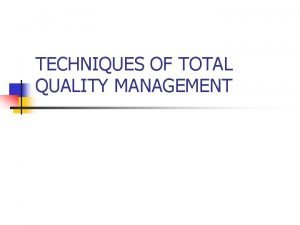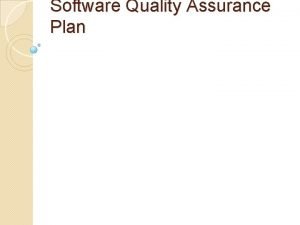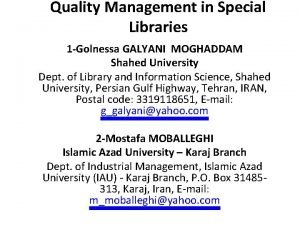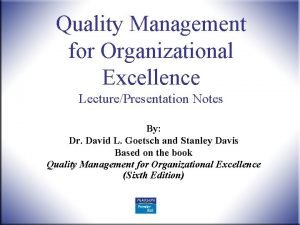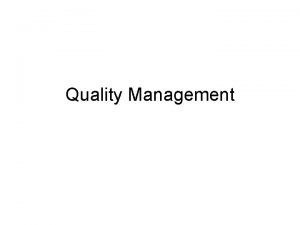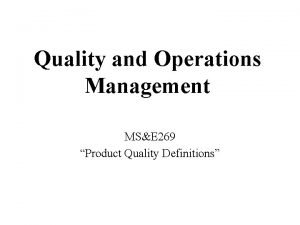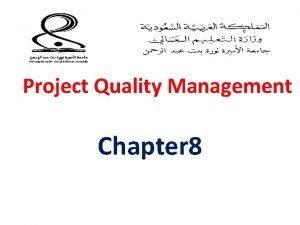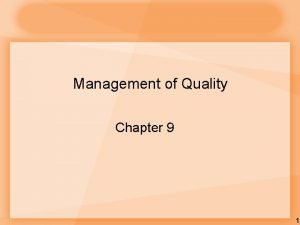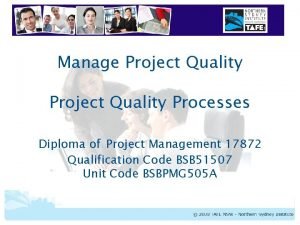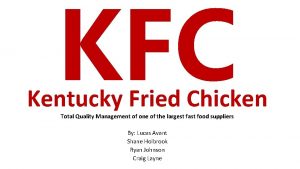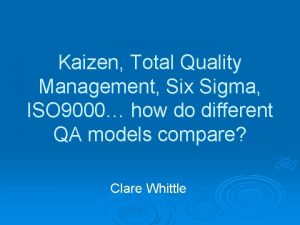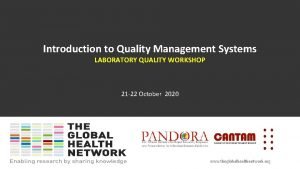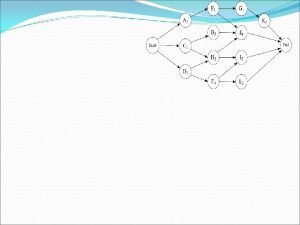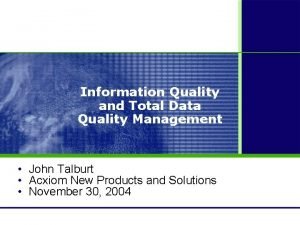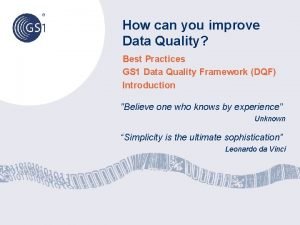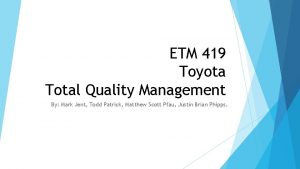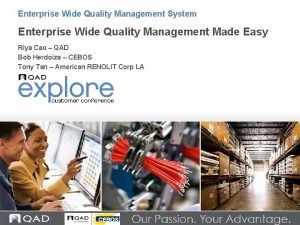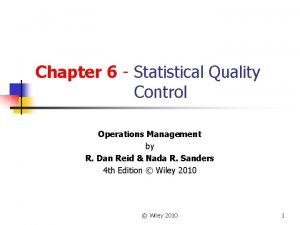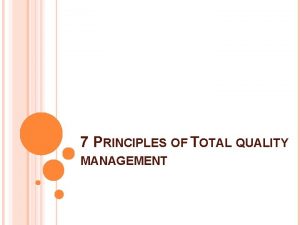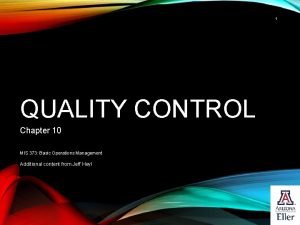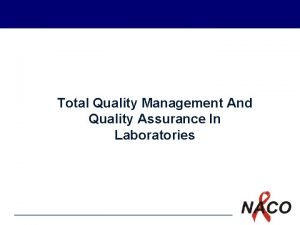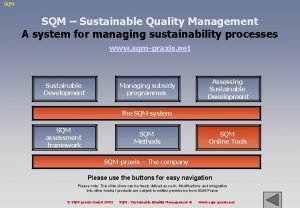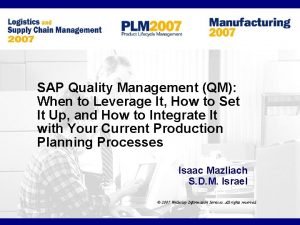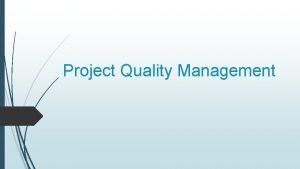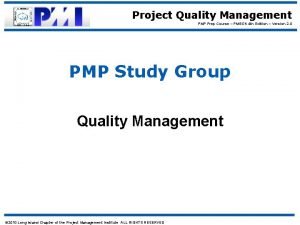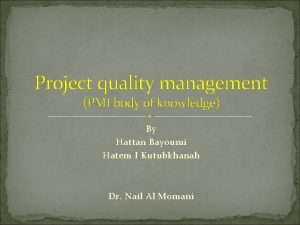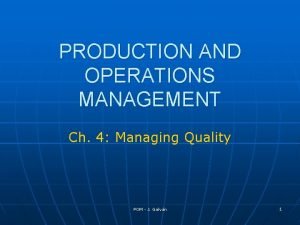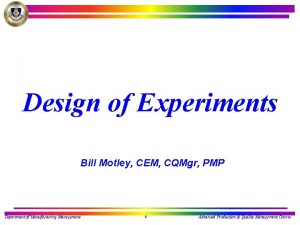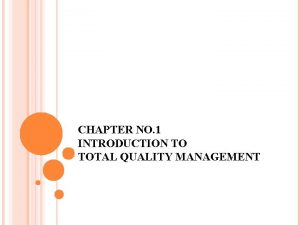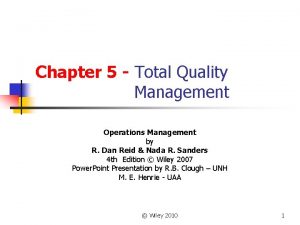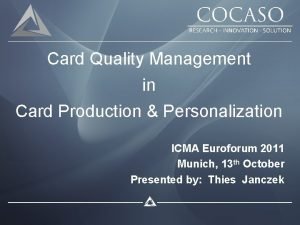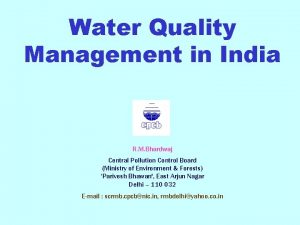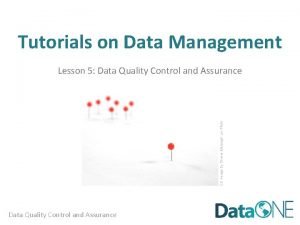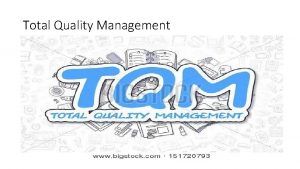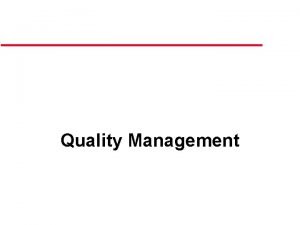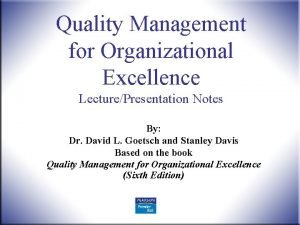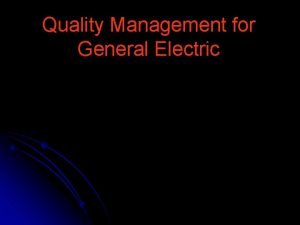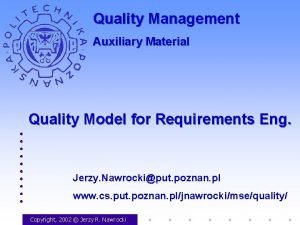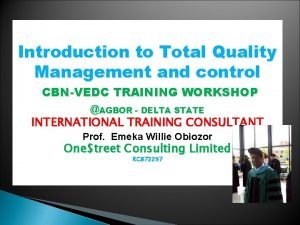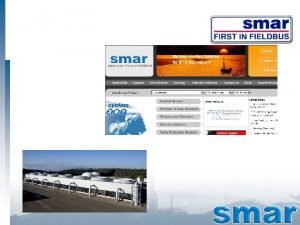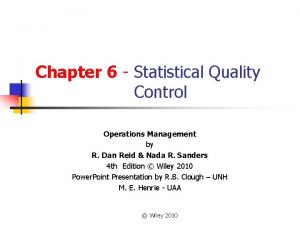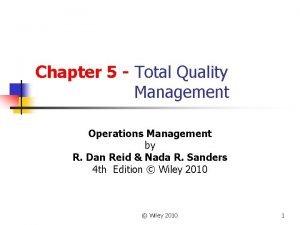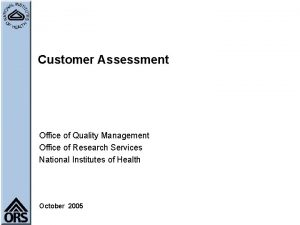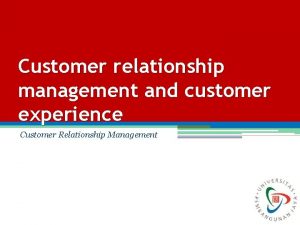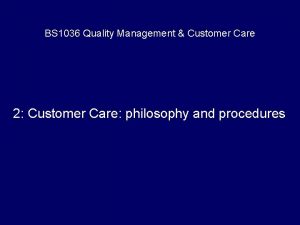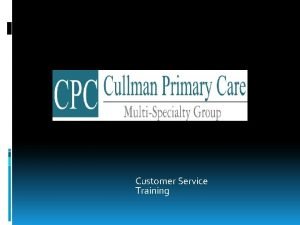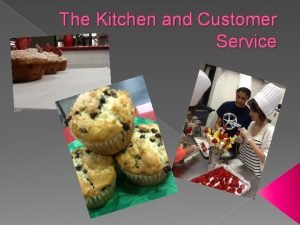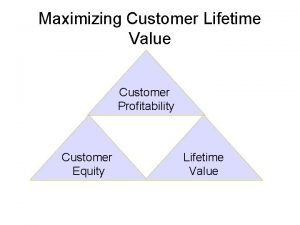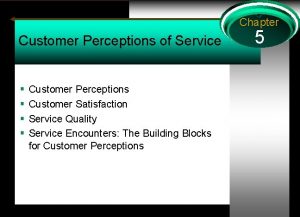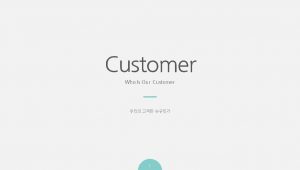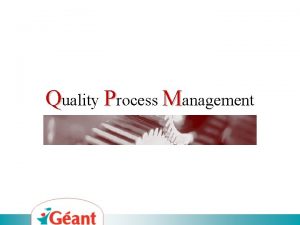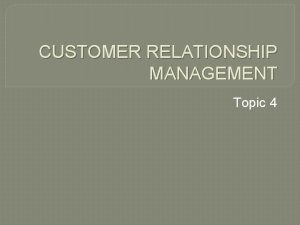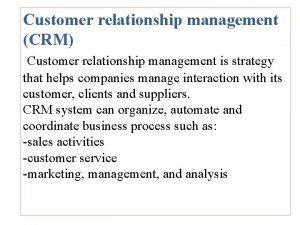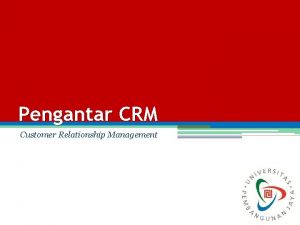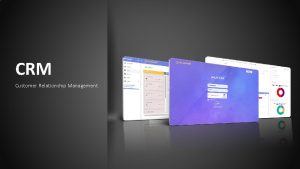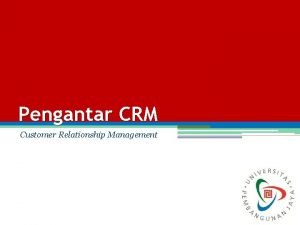Customer Assessment Office of Quality Management Office of































































































































- Slides: 127

Customer Assessment Office of Quality Management Office of Research Services National Institutes of Health October 2005

For more information on Performance Management in the Office of Research services: http: //www. ors. od. nih. gov/OD/OQM/Pages/index. aspx Or Contact: Antonio Rodriguez Rodrigan@mail. nih. gov (301) 402 -3440 Acknowledgments This training was developed by SAIC and the Office of Quality Management.

Training Objectives • Introduction • Customer Assessment and Performance Management • Customer Relationship Management • The 10 Steps • Conclusion 3

Customer Assessment and Performance Management The Balanced Scorecard for Your Organization How do we exceed Customer/stakeholder expectations? Customer What do our customers/ stakeholders look for in financial results? Financial Internal Strategy What process do we need to improve to fulfill these expectations? Learning What skills, tools, and culture are required to perform these processes? 4

Performance Measurement Model What inputs? What processes? What products/services? 5

Customer Intimacy Is Customer Quality Relationships • Understand their business • Empower them • Know their needs • Share with them • Provide complete solutions • Our team knows their team • Quality of the relationship • Follow up and feed back 6

Examples of Customer Objectives ORS a nd OR F EXAM PLE OBJEC TIVES • Provide integrated transparent access to the most relevant information via the most effective information sources for NIH researchers and staff • Improve education of customers on portfolio of services offered by Events Management • Be readily available to our customers to provide information, customer service, and resolve issues regarding transportation and parking services • Improve communication with customers • Meet customer needs by providing the right mix of specialized research support services • Improve customers’ business decisions • Improve as single-source contact on ORS-wide administrative processes • Increase responsiveness to customers’ varying needs • Increase customer satisfaction with our products and services 7

Customer Relationship Management (CRM) Customer measurement a piece of CRM • Describes the many activities in managing relationships with customers What is a relationship? • • Continuing series of collaborative interactions Occurs over time Develops based on successive interactions Unique for each customer Why management? • Each interaction offers: • Ability to customize products/services to customers • Opportunity to influence customers’ perceptions • Learn more about customers for the future • Management of relationship encourages loyalty

© 2001 The New Yorker Collection from cartoonbank. com. All Rights Reserved 9

Why should YOU care about managing customers? Times have changed • • Customers have escalating needs Competitors are delivering on these demands If you don’t, you will be out of business Computer technology has contributed to this new world Business Case • • • Dissatisfied customers usually don’t complain Dissatisfied customers usually do defect Dissatisfied customers tell everyone they know Dissatisfied customers encourage others to defect Result --- lost business…. . forever!! 10

Why should ORS/ORF care about managing customers? Management Case • NIH stakeholders want to see data • How ORS/ORF knows we are satisfying customers • Why ORS/ORF should be the provider of choice • How ORS/ORF is planning to meet future customer needs Government Case • Should ORS/ORF be sole source of products/services • Can others (government or private) be providers • Cost important but also value • GPRA • Explain in quantifiable terms how serving customers • Value provided in fulfilling Agencies’ missions • Why we should continue to receive funding and support 11

If you can’t measure it, you can’t manage it. 12

Where do you start? © 2001 The New Yorker Collection from cartoonbank. com. All Rights Reserved. 13

The 10 Steps 1. Select the service area to measure 2. Define products/services delivered to customers 3. Identify customer segments 4. Conduct targeted customer interactions 5. Research competitors 6. Select measures 7. Plan data collection 8. Gather and analyze customer data 9. Discuss findings and recommendations 10. Take action 14

Step 1 Select Service Areas to Measure

Step 1 (cont. ) Select Service Areas to Measure Best to prioritize areas to measure In ORS/ORF, the PMP process is the key to understanding what is important. Select those that are most important • What are the “High Impact” objectives? • In general, • • Visibility to customers Complaints concerning quality Revenue generated High costs of operations Desire to understand why product/service is successful Initiatives to increase market share Requests to demonstrate service usefulness

Step 2 Describe Products/Services © 2001 The New Yorker Collection from cartoonbank. com. All Rights Reserved. 17

Step 2 (cont. ) Describe Products/Services Some questions to answer: • What categories of products/services are delivered to customers? • Why are some categories used more than others? • Has the delivery of products/services increased, decreased, or remained constant? • Why have these changes occurred? • Are particular NIH ICs using the product/service more than others? • If so, why? • Who is ordering, receiving, and using the products/services? • Do your IT systems provide enough information to answer these questions? 18

Step 2 (cont. ) Graph what You Deliver to Customers Example 2 -1 • Division of Veterinary Resources (DVR) Procurement Orders Processed by Customer and Fiscal Year Example 2 -2 • Categories of Products Ordered from MAPB by Fiscal Year Example 2 -3 • NIH Transhare Participants by Month Example 2 -4 • FY 04 Flow Chart of the Division of Radiation Safety Review of Animal Study Program (ASP) Proposals 19

Step 2 (cont. ) Example 2 -1: FY 04 DVR Procurement Orders Processed by Customer and Fiscal Year 20

Step 2 (cont. ) Example 2 -2: Categories of Products Ordered from MAPB by Fiscal Year 21

Step 2 (cont. ) Example 2 -3: NIH Transhare Participants by Month 22

Step 2 (cont. ) Example 2 -4: FY 04 Flow Chart of the DRS Review of ASP Proposals 23

Step 3 Identify Customer Segments 24

Step 3 (cont. ) Identify Customer Segments Segmentation means to sort customers into groups based on similar characteristics Critical to the viability of service organizations Segmentation allows understanding of the differences in customer groups • • What they like - what they don’t like How to tailor service offerings to better meet needs of each group By identifying and tracking customer segments over time • • Determine which segments are most profitable to target and retain Determine which segments to deemphasize 25

Step 3 (cont. ) How do I Segment my Customers? Use existing data to understand: • • • Type of products/services used Quantities of use Customer’s organization Customer’s function Other demographic variables • Location • Type of business • Delivery schedule 26

Step 3 (cont. ) Graph Data to Understand Customer Segments Example 3 -1 • Library Translation Customers by Fiscal Year Example 3 -2 • FY 04 Division of International Services (DIS) Visas Processed by Type 27

Step 3 (cont. ) Example 3 -1: Library Translation Customers by Fiscal Year 28

Step 3 (cont. ) Example 3 -2: FY 04 DIS Visas Processed by Type 29

Step 4 Conduct Needs Assessment © 2001 The New Yorker Collection from cartoonbank. com. All Rights Reserved. 30

Step 4 (cont. ) Conduct Needs Assessment Existing data may not reveal what matters most to customers • Providing what customers really need vs. providing what you think customers need Needs Assessments allow you to learn more about your customers • First review data from prior steps • Look at additional sources – e. g. complaints, stakeholder input, data showing a particular service is over/under-used • Develop list of questions • Gather data via: • Targeted interactions • Interviews • Focus Groups • Survey of customers 31

Step 4 (cont. ) Conduct Needs Assessment (cont. ) • Example 4 -1 • FY 04 Animal Program Advisory Committee (APAC) Feed and Bedding Focus Group • Example 4 -2 • FY 04 Scientific Equipment and Instrumentation Branch (SEIB) Needs Assessment survey 32

Step 4 (cont. ) Example 4 -1: APAC Feed and Bedding Focus Group (Slide 1 of 3) Division of Veterinary Resources (DVR) Basic Animal Life Support Service Group analyzed data regarding its feed and bedding processes • FY 02 and FY 03 data suggested that the acquisition and storage of feed and bedding products as well as the quality assurance testing of these products should be further examined – especially with respect to customer needs • A focus group was held with APAC members in FY 04 to gather data on customer needs 33

Step 4 (cont. ) Example 4 -1: APAC Feed and Bedding Focus Group (Slide 2 of 3) • A structured series of questions were asked of members and action items generated based on the data gathered • • • Is the current ordering process for feed and bedding products working? Explain. Currently how confident are you that you can get feed and bedding when you need it? Have you had problems related to the delivery of feed and/or bedding? Have you found the OLAO staff to be responsive to your needs? Have you had ongoing issues related to the quality of either the feed or bedding products delivered? Do you think NIH should continue to do additional quality assurance checks on feed and bedding products beyond the tests run by the manufacturers? 34

Step 4 (cont. ) Example 4 -1: APAC Feed and Bedding Focus Group (Slide 3 of 3) • • When you have a quality issue, do you contact Dennis Barnard in DVR or do you contact OLAO staff or both? Would you find it helpful to have all issues about feed and bedding be handled by one person in DVR? Why or why not? Some organizations eliminate their warehousing function as a way to reduce costs, and receive their supplies directly from vendors just-in-time – meaning they receive the products just as they are ready to use them. How would you feel about going to such a system for animal feed and bedding products? Explain. Customer input verified necessity of current acquisition and storage procedures 35

Step 4 (cont. ) Example 4 -2 : FY 04 SEIB Needs Assessment Survey was designed to determine the need for instrument design and fabrication services among NIH intramural Principal Investigators (PIs) What was discovered: • About 90% of all intramural PIs completed the survey • 34% of PIs expressed a need for instrument fabrication and design services • Almost half of all jobs are urgent or emergencies • About 40% of PIs used outside sources for design and fabrication work 36

Step 4 (cont. ) Example 4 -2 : FY 04 SEIB Needs Assessment Survey (cont. ) Do you require any of the following services for instrument fabrication and design? 34% expressed need for instrument fabrication and design (N=320) N = 935 Number of Respondents 66% expressed no need Note: Multiple responses possible in last four categories. 172 respondents skipped this question. 37

Step 5 Research Competitors © 2001 The New Yorker Collection from cartoonbank. com. All Rights Reserved. 38

Step 5 (cont. ) Research Your Competitors Why should ORS/ORF be the provider of choice? Ask yourself: • Who else can provide this service? • At what cost can others provide this service? • What does ORS/ORF offer that is unique or valued compared to competitors? • What do competitors offer in terms of features and amenities that are not offered by ORS/ORF? • What distinguishes you from your competitors? • What are you doing to increase market share? What is the value proposition for your service area? 39

Step 6 Select Measures 40

Step 6 (cont. ) Typical Balanced Scorecard Customer Measures Customer satisfaction • How well meeting needs and satisfaction with specific performance criteria Market share • Proportion of business in market that you provide to customers Customer retention • Do you maintain ongoing relationships with customers and retain their business Customer acquisition • Rate at which you attract new customers Customer profitability • Net profit of a customer segment accounting for unique expenses to support that customer 41

Step 6 (cont. ) Some Advice About “Measures” Rarely can you gather data and use it directly to gauge performance • Data needs to be collected, transformed, analyzed, summarized, and displayed Most measures are calculated based on a series of raw data metrics • Customer satisfaction may be the overall satisfaction score on a 20 question survey • Market share may be combination of percentage of market for variety of products/services • Customer retention may be combination of retention of many different customers, segments There is no one “right” measure Be flexible to change measures • Example 6 -1 • FY 05 Division of Facilities Planning (DFP) Customer Scorecard 42

Step 6 (cont. ) Example 6 -1: FY 05 DFP Customer Scorecard 43

Step 7 Plan Data Collection © 2001 The New Yorker Collection from cartoonbank. com. All Rights Reserved. 44

Step 7 (cont. ) THINK Before you Act! • Data collection is a time consuming activity • Gathering data from customers raises their expectations • Only collect the amount of data you can analyze and respond to in timely fashion • Garbage in = Garbage out 45

Step 7 (cont. ) Methods for Collecting Data Existing Data Observation Interviews and Focus Groups Surveys 46

Step 7 (cont. ) Existing Data (cont. ) Financial data, ordering data, delivery data, complaints data Steps to using existing data: • Select appropriate data • Define data into measures • Determine computational procedures to use measures as information Example 7 -1 • Scientific Equipment Instrumentation Branch (SEIB) Rental Revenue by Fiscal Year 47

Step 7 (cont. ) Example 7 -1: SEIB Rental Revenue by Fiscal Year 48

Step 7 (cont. ) Existing Data - Advantages • Easy to gather • Doesn’t require involving the customer • Often viewed as “objective” or “real” • Can be summarized over time • Allows quick review of current situation • Typically used to convince management that something needs to change 49

Step 7 (cont. ) Existing Data - Disadvantages • Quality of the data may be poor - not recorded in consistent fashion • Data may be incomplete • Extraction of data may be time consuming • Not collected with analysis in mind • May have limited usefulness 50

Step 7 (cont. ) Observations • Simple to do • Great reality check on how things really happen • Very useful to understand new features, amenities you could provide • Example 7 -2 • FY 05 Security Guard Observations of Wait Times for Vehicle Security Checks 51

Step 7 (cont. ) Example 7 -2: FY 05 Security Guard Observations of Wait Times for Vehicle Security Checks 52

Step 7 (cont. ) Observations - Advantages • Yield real time data • Provide understanding of context • Outsiders can be used so data has little bias • See things that escape notice in general course of work • Access to information people may not want to discuss in interviews 53

Step 7 (cont. ) Observations - Disadvantages • Can be costly if have to train observers • Limitations due to people’s concerns about anonymity and being observed • Presence of observer may influence process • Can be hard to code and analyze 54

Step 7 (cont. ) Interviews and Focus Groups Difference • Interviews are conducted with individuals • Focus groups consist of multiple participants Good for collecting qualitative data • Information not readily categorized and coded • Explore why customers feel they way they do Questions are usually open-ended in nature • Let customers respond in their own words • Provides insight into customer perceptions Example 7 -3 • FY 03 ORS Financial Management Branch (FMB) Customer Interviews 55

Step 7 (cont. ) Example 7 -3: FY 03 ORS FMB Customer Interviews (Slide 1 of 4) • Interviews were conducted with representatives in ORS to capture how the ORS Financial Management Branch (FMB) can provide better service to its customers. • Total of 13 interviews were held and most lasted 1 hour • Combined open ended questions with a structured survey (ORS customer scorecard) • Summary of results were compiled 56

Step 7 (cont. ) Example 7 -3: FY 03 ORS FMB Customer Interviews (Slide 2 of 4) How the results were used: • FMB took action to clarify its role, especially in the budget reporting process • FMB was able to partner with Divisions and become a better advocate for them with OFM • Results helped reaffirm FMB’s commitment to a customer service mentality. 57

Step 7 (cont. ) Example 7 -3: FY 03 ORS FMB Customer Interviews (Slide 3 of 4) Open Ended Questions: • Business plan formulation questions • How well do you think the current business plan formulation process works? • What specific ideas do you have to improve the process? • What tools or services could the FMB provide to assist you in this process? • Budget execution questions • Do the current reports and information you receive meet your needs to track your budget obligations/accruals/expenditures? • How could the reports/information be modified so you would NOT have to manipulate it to use it? • How much has timeliness and accuracy of budget execution information been an issue for you? 58

Step 7 (cont. ) Example 7 -3: FY 03 ORS FMB Customer Interviews (Slide 4 of 4) Open Ended Questions (cont. ): • Central Services Questions to be Asked • Do the current Central Services reports and information you receive meet your needs to track your budget obligations/accruals/expenditures? • What specific ideas do you have on how we provide this information to you in a useful manner and timeframe? • Questions for Rate Study Customers • What services does the Budget and Finance group currently provide for your rate studies? • What could we do to improve our service to you in this area? • General • Do you have any additional specific ideas on how the Budget and Finance Service Group can improve our service to you? 59

Step 7 (cont. ) Interviewing is a Skill © 2001 The New Yorker Collection from cartoonbank. com. All Rights Reserved. 60

Step 7 (cont. ) Interviews/Focus Groups - Advantages • Allow flexibility in data collection • Can gather unexpected data and ask unplanned questions • Provide more complete customer perspective • Facilitate communication and customer relations • Useful for generating ideas for improvement • Allow for problem-solving during the actual meeting 61

Step 7 (cont. ) Interviews/Focus Groups - Disadvantages • Require skilled interviewers or they can backfire • Produce results that can be difficult to analyze and interpret with assistance • Can produce biased results • Social desirability or peer pressure (focus groups) can be influential 62

Step 7 (cont. ) Surveys • Doing a good survey is NOT simple • Obtaining useful information requires skill and practice • The method (e. g. doing a web survey) is just part of the process • Need to consider issues of anonymity and confidentiality • There is no “magical” number of questions • Response rates are key to evaluating surveys -- how the data can be used • Don’t do a survey unless you plan to act on the results 63

Step 7 (cont. ) Components of a Survey • Introduction • Reasons for survey • Guaranteeing anonymity • Instructions • Survey Questions • Satisfaction surveys • Needs assessment surveys • Climate surveys • Comments • Offer respondents chance to comment • Closing • Thank you • Assurance that results will be made available 64

Step 7 (cont. ) Introduction • Example 7 -4 • FY 05 Division of Facilities Planning Customer Scorecard 65

Step 7 (cont. ) Example 7 -4: FY 05 Division of Facilities Planning Customer Scorecard Introduction • The Division of Facilities Planning in the Office of Research Facilities is gathering customer feedback on the planning services it provides ICs so that we know how to better satisfy your needs. Each IC is being asked for one response representing the consolidated views of the IC. Your responses will be combined with the responses of others and analyzed by the Office of Quality Management in the Office of Research Services. Thus the information you provide will remain anonymous. Please take a few minutes to complete this survey. 66

Step 7 (cont. ) Survey Questions: Customer Satisfaction Surveys • Customer Satisfaction Dimensions • Common satisfaction dimensions apply to all/most Service Groups • Use these dimensions whenever possible • Advantage: Allows OQM to roll-up ratings across Service Groups • Example 7 -5 • ORS Customer Scorecard 67

Step 7 (cont. ) Example 7 -5: ORS Customer Scorecard Customer Satisfaction Dimensions Please rate your SATISFACTION with <Service Group or Product Name> on the following: 68

Step 7 (cont. ) Survey Questions: Satisfaction Surveys • Satisfaction With Specific Performance Aspects • Satisfaction ratings may be obtained on any aspect of service or product performance • Work with OQM to define questions • Example 7 -6 • FY 05 Space Administration and Finance Branch (SAFB) Consolidated Statement of services (CSS) survey • Example 7 -7 • FY 05 Division of Radiation Safety Laboratory Transfer survey 69

Step 7 (cont. ) Example 7 -6: FY 05 SAFB CSS Survey Other Types of Satisfaction Questions Answer the following questions regarding the NIH Rent Program section of the CSS. Indicate the extent to which you agree or disagree with the following statements. Please answer the following question for the CSS overall. 70

Step 7 (cont. ) Example 7 -7: FY 05 Division of Radiation Safety Laboratory Transfer Survey Other Types of Satisfaction Questions Please rate the helpfulness of the information provided to you in the following areas: How helpful was the assistance you received from your Area Health Physicist? 71

Step 7 (cont. ) Survey Questions: Needs Assessment Surveys • Frequency of Product/Service Use • Helps prioritize services and/or products already offered • Helps identify outside service provider impact • Example 7 -8 • FY 04 Scientific Equipment and Instrumentation Branch (SEIB) Needs Assessment survey: Frequency of Product/Service Use • Example 7 -9 • FY 04 Scientific Equipment and Instrumentation Branch (SEIB) Needs Assessment survey: Product/Service Use by Service Provider 72

Step 7 (cont. ) Example 7 -8: FY 04 SEIB Needs Assessment Survey Frequency of Product/Service Use N = 246 Is most of your work: Type of Work 23% 14% 55% 8% Number of Responses Note: Only answered by those expressing need for instrument fabrication and design services (N=320). 74 respondents skipped this question. 73

Step 7 (cont. ) Example 7 -9: FY 04 SEIB Needs Assessment Survey Product/Service Use by Service Provider Respondents were asked to indicate their service providers for Instrument Modification Number of Respondents 28% used ORS SEIB 27% used Outside Sources (Commercial Job Shops or Other Source) N = 266 Note: Only Service Providers with responses are shown. Multiple responses possible. 74

Step 7 (cont. ) Survey Questions: Needs Assessment • Determination of Additional Products or Services Needed • Helps determine what additional services or products are in demand • Example 7 -10 • FY 05 Information Technology Branch (ITB) Needs Assessment survey: Importance and Criticality Ratings • Example 7 -11 • FY 05 Information Technology Branch (ITB) Needs Assessment survey: Importance and Criticality Classification • Example 7 -12 • FY 05 Information Technology Branch (ITB) Needs Assessment survey: After Hours Support Use 75

Step 7 (cont. ) Example 7 -10: FY 05 ITB Needs Assessment Importance and Criticality Ratings Importance Ratings • For each application used by an Office/Division, respondents were asked to rate the importance of having after hours support for the IT application. • The scale ranged from (1) Not Important to (10) Very Important. Criticality Ratings • For each application used by an Office/Division, respondents were asked to rate the amount of time that their business operation could tolerate (i. e. , operate effectively) when the application is not fully functional. • The scale included 5 choices; (1) 1 hours or less, (2) 2 – 4 hours, (3) 4 – 8 hours, (4) 8 – 12 hours, and (5) 12 hours or more. 76

Step 7 (cont. ) Example 7 -11: FY 05 ITB Needs Assessment Importance and Criticality Classification Importance High Criticality High Low CPR Training – Online Registration Filemaker Pro 5. 5 Laboratory Safety NIH Shuttle Online Interpretive DOES Automated Inspections Parking and Transhare Andover Continuum DIS Training System AO Services System Dynamic Survey SPSS and Survey Development Bldg 10 Revitalization DPPA Survey JJ Keller Revitalization Leased Property ORF – IBC Training Registration ORF Training Registration Remedy ITB Help Desk Remedy Change Management CRIS BITS Remedy Knowledgebase NIH Census OSIS Posted Space Application Space Justification Log Project Server 2003 ORS Services Administration Remedy DPS Training App Remedy Facility Risk Weapons Inventory VRP Billing System ARCHIBUS Calendar Module DPPA Time Management Qualtrax ORF Reference Library Capacity Management Rational Radiation Safety Irradiator Remedy Web Client CATWeb OBSF Business Tool ORS Training Registration VSOF Medium Low Medium Note ORF Applications in red font 77

Step 7 (cont. ) Example 7 -12: FY 05 ITB Needs Assessment After Hours Support Use Respondents were asked to estimate how many times they would have called ITB for support during the past 6 months had they been available during specific time frames. Results are ordered by frequency from heaviest use to lowest use. 78

Step 7 (cont. ) Survey Questions: Climate Surveys (Slide 1 of 3) • Climate is defined as the practices and procedures in an organization that connote or signal to people what is important (Schneider, 1975) • Climate has been shown to promote a variety of positive internal organizational outcomes such as employee satisfaction, employee productivity, employee turnover, and employee use of training • Climate has also been shown to promote a variety of positive external organizational outcomes such as increased production and customer satisfaction • Work with OQM to define climate dimensions and questions that are appropriate for your Service Group 79

Step 7 (cont. ) Survey Questions: Climate Surveys (Slide 2 of 3) • Climate Dimensions • Typical dimensions include policies, practices, and procedures related to • Management • Mission/vision clarity and relationship to customer • Supervisory practices • Performance measurement • Communication • Among Service Group employees • Between Service Groups • Between senior management and Service Groups • Teamwork • Among Service Group employees • Between Service Groups • Training • Are employees trained? • Do employees use the training they have received? • Rewards • Are employees rewarded for good performance • Is good performance tied to mission, customer expectations, etc. 80

Step 7 (cont. ) Survey Questions: Climate Surveys (Slide 3 of 3) • Climate Examples • Example 7 -13 • FY 04 Division of Events Management Climate Survey • Example 7 -14 • FY 04 Division of Employee Services (DES) Worksite Enrichment Climate Survey • Example 7 -15 • FY 04 Office of Quality Management (OQM) Performance Management Survey 81

Step 7 (cont. ) Example 7 -13: FY 04 Division of Events Management Climate Survey Management Dimension: Ratings by Question and Type of Respondents were asked to rate the extent of their satisfaction on the following climate aspects. Mean Response Management Questions N=7 N = 23 N=6 N = 23 N=7 N = 23 Strongly Disagree Strongly Agree 82

Step 7 (cont. ) Example 7 -14: FY 04 DES Worksite Enrichment Climate Survey Respondents were asked to rate the extent of their satisfaction on the following climate aspects. N=9 Climate Aspect N=9 N=9 Unsatisfactory Outstanding 83

Step 7 (cont. ) Example 7 -15: FY 04 OQM Performance Management Survey Respondents were asked to rate the extent of their agreement with the following statements N = 40 N = 39 Climate Aspect N = 40 N = 39 N = 40 Strongly Disagree Neither Agree nor Disagree Strongly Agree 84

Step 7 (cont. ) Types of Survey Questions • Demographic questions • Example 7 -16 • FY 04 Division of Events Management Climate Survey • Yes/No questions • Example 7 -17 • FY 04 Division of Employee Services (DES) Worksite Enrichment Customer Survey • Check all that apply questions • Example 7 -18 • FY 04 Division of Employee Services (DES) Worksite Enrichment Customer Survey 85

Step 7 (cont. ) Example 7 -16: FY 04 Division of Events Management Climate Survey Demographic Questions demographic questions allow you to view results by type of respondent 86

Step 7 (cont. ) Example 7 -17: FY 04 DES Worksite Enrichment Survey Yes/No Questions In general, yes/no questions should be avoided unless you use them to stratify responses (e. g. , exclude those respondents who answer “no”, or view results by whether respondents chose “yes” or “no” to certain qualifying question) 87

Step 7 (cont. ) Example 7 -18: FY 04 DES Worksite Enrichment Survey Check All That Apply Questions In general, check all that apply questions should be avoided unless you’d like to examine responses collectively irrespective of the number of respondents 88

Step 7 (cont. ) Comments • Are examples of open-ended questions • Always provide an opportunity for respondents to comment • Providing a structured way for respondents to comment is helpful to focus comments on important areas • Example 7 -19 • ORS Customer Scorecard • Other open-ended questions 89

Step 7 (cont. ) Example 7 -19: ORS Customer Scorecard and Other Open-Ended Questions • ORS Customer Scorecard Questions • What was done particularly well? • What needs to be improved? • Other comments? Open-ended questions provide a good source of ideas on how to improve • Other Open-Ended Questions • Are there any additional services or amenities would you like to see added? • If the Division of Employee Services could do one thing to improve the quality of your work life, what would it be? • Is there any additional training that you would find beneficial? • Do you have any comments on how we can improve our business planning process? 90

Step 7 (cont. ) Closing • Closing • Thank you • Assurance that results will be made available • Examples • Thank you for your time. We will post survey results on our website <website location> and notify you when the results are available. • Thank you for your feedback. 91

Step 7 (cont. ) Survey Sampling and Administration • Sampling is for statisticians • Define population/sampling frame/actual sample • Plan for post-stratification weighting procedures • Administration • Web surveys are the way to go • • Authentication Respondent control Branching Data validation • Point of sale surveys • Don’t necessarily generalize to the larger population • Good for tapping current customers • Effective method to solicit improvement ideas • Mail surveys • Response rates and incentives 92

Step 7 (cont. ) Survey Tips (Slide 1 of 6) • Rating Scales • Typical rating scales vary from 5 to 10 rating choices • There is no one “correct” or “best” rating scale • Even numbers of rating choices discourage “fence sitters” (e. g. , neither agree nor disagree) • There is no need to label each and every rating point on a scale. It is often sufficient to label only the low end and high end of a scale • The ORS Customer Scorecard uses a 10 -point rating scale • The larger number of points are useful to ensure a greater amount of variation among responses • Useful when respondents are closely bunched on one end of the scale or the other • A greater amount of variation is useful when making comparisons (e. g. , among types of respondents, over time, etc. ) • In general, use a 10 -point scale when possible 93

Step 7 (cont. ) Survey Tips (Slide 2 of 6) • Don’t Know and Not Applicable • Typical rating scales allow respondents to choose “Don’t Know” or “Not Applicable” • Include these choices unless you are absolutely sure that respondents have no reason to choose one or the other • When these choices are not available on a survey you may find an inordinate number of questions are not answered. You’ll have no idea why. 94

Step 7 (cont. ) Survey Tips (Slide 3 of 6) • Pitfalls of Yes/No Questions • Avoid using Yes/No questions • Use Yes/No questions only when the answer is used for the purpose of stratifying responses or branching. • Answer will be used to compare answers of respondents who chose “yes” to those who chose ”no” on some other dimension • Answer leads to different path on survey. • Inappropriate • Reviews are timely ___Yes ___No • Your Area Health Physicist was helpful ___Yes ___No • Better • How timely were our reviews? Use a rating scale from (1) Not at all Timely to (10) Extremely Timely. Include “Don’t Know” and “Not Applicable”. • How helpful was the assistance you received from your Area Health Physicist? Use a rating scale from (1) Not at all Helpful to (10) Extremely Helpful. Include “Not Applicable”. 95

Step 7 (cont. ) Survey Tips (Slide 4 of 6) • Soliciting Respondents Name/Email address • Always make this optional • Can be useful depending on purpose of survey • Needs assessment surveys • Allows you to get back to respondent with specific information at his/her request • In general, avoid asking for this information • Most respondents uncomfortable • Results no longer anonymous 96

Step 7 (cont. ) Survey Tips (Slide 5 of 6) • Survey Frequency • Needs assessment surveys • A one-time survey • Customer satisfaction and climate surveys • • Dependent on size of customer pool, results, etc. Do not want to over-survey In general, every 2 years may be just about right Point-of-sale or contact surveys • Survey all customers for a short period of time, several times per quarter • Survey every nth customer on an on-going basis 97

Step 7 (cont. ) Survey Tips (Slide 6 of 6) • Sharing Results • Make sure to share results with stakeholders • Senior ORS/ORF leaders • Service Group team members • Customers (respondents) • Promotes positive relationship with customers • Encourages sharing of ideas with customers • Provides means to educate customers on Service Group capabilities 98

Step 7 (cont. ) Surveys - Advantages • Used to gather large amounts of data quickly • Permit anonymity - thus honest feedback • Use sampling techniques so don’t bother customers • Provide results that generalize to larger population of customers • Data can be summarized analyzed using statistical tests 99

Step 7 (cont. ) Surveys - Disadvantages • Not as flexible as interviews/focus groups • Raise customer expectations that things will improve • Low response rates and non-response bias can lead to faulty conclusions • Data gathered may not generalize to larger population • Expensive in terms of development, administration, analysis 100

Step 7 (cont. ) Get Assistance from OQM © 2001 The New Yorker Collection from cartoonbank. com. All Rights Reserved. 101

Step 7 (cont. ) Data Collection Plan • * Use the template(s) available to help you define your measures • Measure Roadmap, or • Data Collection Plan • Templates walk you through the measurement definition and collection process and specify, …. . • • • performance measure link to objective methodology used for data collection ownership of measure source of data frequency of data collection targets * Available at http: //www. nih. gov/od/ors/od/oqm/pm/index_pm. htm and described in Managing With Measures, June 2004 102

Step 8 Gather and Analyze Customer Data 103

Step 8 (cont. ) Steps in Gathering Customer Data Steps to Gather Customer Data • • • Pilot test data collection tools Determine dates and locations for data collection Publicize data collection effort (if relevant) Start data collection period Collect the data Provide follow-up reminders if applicable End data collection period Enter data into the appropriate IT system Check/transform the data as needed Analyze the data and product summary graphs, charts, tables 104

Step 8 (cont. ) Analyzing Customer Data • There are generally two types of data: quantitative and qualitative • Analyzing data is not simple – contact OQM for assistance • There is both an art and a science to analyzing data • Compare yourself over time or to others to better understand your results • Highlight similarities and differences • Categorize findings in a way that tells a story • Do NOT report all the data -- be selective 105

Step 8 (cont. ) Analyzing Data is a Skill 106

Step 8 (cont. ) Types of Charts and Graphs • Pie Charts • Example 8 -1 • FY 04 Bioengineering and Physical Science Collaboration Needs Assessment • Bar Charts • Example 8 -2 • FY 05 Support Foreign Staff Exchange Program Division of International Services (DIS) Visiting Program Participant Survey • Example 8 -3 • FY 04 Office of Research Facilities Senior Leadership Survey • Line Graphs • Example 8 -4 • FY 04 ORS Customer Scorecard Roll-up Results 107

Step 8 (cont. ) Types of Charts and Graphs (Cont. ) • Pareto Charts • Example 8 -5 • FY 04 Office of Quality Management (OQM) Performance Management Survey • Gap Analysis • Example 8 -6 • FY 03 Library Translation Services Customer Scorecard 108

Step 8 (cont. ) Example 8 -1: FY 04 Bioengineering and Physical Science Collaboration Needs Assessment Pie Chart: Respondent Characteristics - Tenure N = 371 109

Step 8 (cont. ) Example 8 -2: FY 05 DIS Visiting Program Participant Survey Bar Chart: Satisfaction – Reliability Frequency of Response N = 112 2% 15% Mean = 8. 77 83% Median = 9 Unsatisfactory Outstanding 110

Step 8 (cont. ) Example 8 -3: FY 04 Office of Research Facilities Senior Leadership Survey Bar Chart: Satisfaction With Service Areas by Organization 111

Step 8 (cont. ) Example 8 -4: FY 04 ORS Customer Scorecard Roll-up Results Line Graph: Satisfaction - Mean Convenience Ratings Outstanding N = 13 Mean = 8. 50 Median = 9. 00 Unsatisfactory * Group significantly different from mean (p <. 05) ** Group significantly different from mean (p <. 01) 112

Step 8 (cont. ) Example 8 -5: FY 04 OQM Performance Management Survey Pareto Chart: Satisfaction - Mean Convenience Ratings Extremely Helpful Not at all Helpful 113

Step 8 (cont. ) Example 8 -6: FY 03 Library Translation Services Customer Scorecard Gap Analysis: Satisfaction and Importance Ratings Note: The Importance rating scale ranges from 1 - 10 where “ 1” represents Unimportant and “ 10” represents Important. The Satisfaction rating scale ranges from 1 - 10 where “ 1” represents Unsatisfactory and “ 10” represents Outstanding. 114

Step 8 (cont. ) Example 8 -6: FY 03 Library Translation Services Customer Scorecard (cont. ) Gap Analysis: Satisfaction and Importance Ratings–A Closer Look Note: A smaller portion of the chart is shown so that the individual data points can be labeled. 115

Step 8 (cont. ) Data Over Time • Example 8 -7 • FY 05 Division of Facilities Planning Customer Scorecard • Example 8 -8 • FY 04 ORS Customer Scorecard Roll-up Results: Overall Service Group Satisfaction Means by Fiscal Year • Example 8 -9 • FY 04 ORS Customer Scorecard Roll-up Results: Percentage Change in Overall Customer Satisfaction 116

Step 8 (cont. ) Example 8 -7: FY 05 Division of Facilities Planning Customer Scorecard Satisfaction Ratings by Fiscal Year N = 14 N = 16 N = 15 Satisfaction Dimension N = 16 N = 15 N = 16 Unsatisfactory Outstanding Note: There are no significant differences between the groups 117

Step 8 (cont. ) Example 8 -8: FY 04 ORS Customer Scorecard Rollup Results Overall Service Group Satisfaction Means by Fiscal Year * Group significantly different from Time 1 (p <. 05) ** Group significantly different from Time 1 (p <. 01) 118

Step 8 (cont. ) Example 8 -9: FY 04 ORS Customer Scorecard Rollup Results % Change in Overall Customer Satisfaction Mean Rating Percentage Change in Overall Customer Satisfaction Appendix shows Service Group number mapping * Significant change (p <. 05) ** Significant change (p <. 01) 119

Step 9 Discuss Findings and Recommendations © 2001 The New Yorker Collection from cartoonbank. com. All Rights Reserved. 120

Step 9 Discuss Findings and Recommendations (cont. ) • Data not worth anything if not reviewed for findings and recommended actions • If issues are identified, some kind of action is imperative • Customers share dissatisfaction and nothing happens -organization has failed them twice • Actions can be thought of as service recovery • Recovery can impact tremendously on satisfaction and loyalty • In general customers have basic expectations 121

Step 9 Basic Expectations of Customers Regarding Service • Customer Expectations • • • • Be competent Explain things Be respectful Keep me informed Be on my side Play fair Protect me from catastrophe Keep your promise Fulfill obligations Learn my business and work with me Share my sense of urgency Be competent Be prepared Be flexible Source: Parasuraman, Berry, & Zeithaml, 1991. 122

Step 9 Interpreting Findings 123

Step 9 Tips for Interpreting Data • Try to see the forest through the trees • Organize your data and findings to tell a story • Get front-line employee involved • Involve customers if they are willing • Organize findings to report both good news and areas for improvement • Develop a presentation summarizing the measurement process, method, findings, and recommendations 124

Step 10 Take Action © 2001 The New Yorker Collection from cartoonbank. com. All Rights Reserved. 125

Step 10 Take Action (Cont. ) • Taking action is the bottom line • If nothing else -- you must provide feedback to customers on findings • Won’t cooperate with future data collection • May negatively impact on their image of you • Balanced Scorecard approach encourages integrating customer data into strategic planning process • Customer data is KEY ingredient in way the organization does business • Customer data should DRIVE organizational improvement • Remember that improvement is a process • Outstanding service doesn’t come over night • It’s not impossible • Just takes commitment to customer satisfaction and quality 126

Conclusion • Customer Assessment is essential to measuring the impact of your strategy • Meant to be used in conjunction with the other perspectives of your PMP • The 10 steps are a guideline to get you started • Customer data helps you answer the question, “How well do I deliver on my “value proposition”? 127
 Customer relationship management and customer intimacy
Customer relationship management and customer intimacy Customer relationship management and customer intimacy
Customer relationship management and customer intimacy Intimacy
Intimacy Managing marketing information to gain customer insights
Managing marketing information to gain customer insights Pengertian customer relationship
Pengertian customer relationship Beyond customer satisfaction to customer loyalty
Beyond customer satisfaction to customer loyalty Functional components of e-crm
Functional components of e-crm Quality is meeting or exceeding customer expectations
Quality is meeting or exceeding customer expectations Quality & customer experience forum
Quality & customer experience forum Bsbcus501 manage quality customer service
Bsbcus501 manage quality customer service Quality management in operations management
Quality management in operations management Supply chain management and total quality management ppt
Supply chain management and total quality management ppt What is tqm
What is tqm Quality assurance vs quality control
Quality assurance vs quality control Quality control vs quality assurance pmp
Quality control vs quality assurance pmp Pmp gold plating
Pmp gold plating Quality assurance model in nursing
Quality assurance model in nursing Compliance vs quality
Compliance vs quality Basic concept of quality control and quality assurance pdf
Basic concept of quality control and quality assurance pdf American quality gurus
American quality gurus Quality is free: the art of making quality certain
Quality is free: the art of making quality certain What is tqm
What is tqm House model translation
House model translation Ich 9
Ich 9 Nqs assessment and rating
Nqs assessment and rating 5 principles of high quality assessment
5 principles of high quality assessment Principles of quality assessment
Principles of quality assessment Education quality and accountability office
Education quality and accountability office Principle of portfolio assessment
Principle of portfolio assessment Static assessment vs dynamic assessment
Static assessment vs dynamic assessment Portfolio assessment matches assessment to teaching
Portfolio assessment matches assessment to teaching Customer accommodation in supply chain management
Customer accommodation in supply chain management Branch automation solutions
Branch automation solutions Recommendation for customer relationship management
Recommendation for customer relationship management Customer relationship management training ppt
Customer relationship management training ppt Crm portfolio
Crm portfolio Airline customer relationship management
Airline customer relationship management Mengapa manajemen portofolio pelanggan penting dilakukan
Mengapa manajemen portofolio pelanggan penting dilakukan What is customer portfolio management
What is customer portfolio management Customer interaction management
Customer interaction management Maturity model template
Maturity model template Elisabeth brinton
Elisabeth brinton Crm software selection criteria
Crm software selection criteria Customer management strategies
Customer management strategies Customer relationship management in retailing
Customer relationship management in retailing Crm in marketing ppt
Crm in marketing ppt Introduction to customer experience management
Introduction to customer experience management Introduction to customer experience management
Introduction to customer experience management Act client management
Act client management Customer relationship management in supply chain
Customer relationship management in supply chain Gap model in retail management
Gap model in retail management Nature of customer relationship management
Nature of customer relationship management Voice of the customer in project management
Voice of the customer in project management Bernd schmitt customer experience management
Bernd schmitt customer experience management Order management & customer service relationship concept
Order management & customer service relationship concept Cayenta customer relationship management
Cayenta customer relationship management Customer service conflict resolution
Customer service conflict resolution Crm and information technology
Crm and information technology Customer value management in banking
Customer value management in banking Customer relationship management kumar
Customer relationship management kumar Portfolio management crm
Portfolio management crm The art of service recovery
The art of service recovery Analytical customer relationship management
Analytical customer relationship management Customer background
Customer background Sugarforge
Sugarforge Market segmentation matrix
Market segmentation matrix Scientific management
Scientific management Management pyramid
Management pyramid Top level management
Top level management Office 365 security assessment questionnaire
Office 365 security assessment questionnaire Secure score api
Secure score api Total quality management tools
Total quality management tools Lean production and quality management
Lean production and quality management What is total quality managment
What is total quality managment Definisi tqm
Definisi tqm Total quality management system
Total quality management system Quality journey
Quality journey Juran's 10 points for quality management
Juran's 10 points for quality management Antecedents of modern quality management
Antecedents of modern quality management Praise analysis
Praise analysis What is total quality management in hospitality industry
What is total quality management in hospitality industry Benchmarking in total quality management
Benchmarking in total quality management Total iit in india
Total iit in india Brainstorming in tqm
Brainstorming in tqm Sqa plans
Sqa plans Conclusion for quality management
Conclusion for quality management Quality management for organizational excellence
Quality management for organizational excellence Quality management definition
Quality management definition Mse in operations management
Mse in operations management Project quality management definition
Project quality management definition Tqm failure
Tqm failure What are quality standards in project management
What are quality standards in project management Tqm of kfc
Tqm of kfc Iso 9000 vs six sigma
Iso 9000 vs six sigma Quality management system in laboratory
Quality management system in laboratory Introduction to quality management
Introduction to quality management Project quality management lecture notes
Project quality management lecture notes John talburt
John talburt Data quality management best practices
Data quality management best practices Toyota motor company tqm
Toyota motor company tqm Enterprise wide quality integrated management software
Enterprise wide quality integrated management software Operations management quality control
Operations management quality control Quality management is not a quick fix
Quality management is not a quick fix Operations management chapter 10 quality control solutions
Operations management chapter 10 quality control solutions How to achieve tqm
How to achieve tqm Sqm quality management
Sqm quality management Sap quality management
Sap quality management Plan quality management tools and techniques
Plan quality management tools and techniques Pmbok
Pmbok Pmi quality management
Pmi quality management Managing quality in operations management
Managing quality in operations management Design of experiments quality management pmp
Design of experiments quality management pmp Introduction to total quality management
Introduction to total quality management Qfd in operations management
Qfd in operations management Quality control card
Quality control card Agricultural quality management
Agricultural quality management Water quality management in india
Water quality management in india Quality control data management
Quality control data management Total quality management wikipedia
Total quality management wikipedia Quality management software for farmers
Quality management software for farmers Objective of quality control
Objective of quality control Quality management for organizational excellence
Quality management for organizational excellence General electric quality management
General electric quality management Material quality management
Material quality management Types of quality
Types of quality Evolution of quality management system
Evolution of quality management system What is sqc in operations management
What is sqc in operations management House of quality operations management
House of quality operations management

